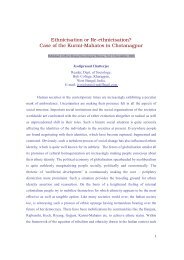Chapter 5 - WebRing
Chapter 5 - WebRing
Chapter 5 - WebRing
You also want an ePaper? Increase the reach of your titles
YUMPU automatically turns print PDFs into web optimized ePapers that Google loves.
CHAPTER 5. MAGNETIC SYSTEMS 235<br />
(a) If B = 4 tesla, at what temperature is 75% of the spins oriented in the +z direction?<br />
(b) Assume that N = 10 23 , T = 1K, and B is increased quasistatically from 1tesla to 10tesla.<br />
What is the magnitude of the energy transfer from the heat bath?<br />
(c) If the system is now thermally isolated at T = 1K and B is quasistatically decreased from<br />
10tesla to 1tesla, what is the final temperature of the system? This process is known as<br />
adiabatic demagnetization. (This problem can be solved without elaborate calculations.)<br />
5.3 Thermodynamics of Magnetism<br />
The fundamental magnetic field is B. However, we can usually control only the part of B due to<br />
currents in wires, and cannot directly control that part of the field due to the magnetic dipoles in<br />
a material. Thus, we define a new field H by<br />
H = 1<br />
µ0<br />
B− M<br />
, (5.21)<br />
V<br />
where M is the magnetization and V is the volume of the system. In this section we use V instead<br />
of N to make contact with standard notation in electromagnetism. Our goal in this section is to<br />
find the magnetic equivalent of the thermodynamic relation dW = −PdV in terms of H, which<br />
we can control, and M, which we can measure. To gain insight into how to do so we consider a<br />
solenoid of length L and n turns per unit length with a magnetic material inside. When a current<br />
I flows in the solenoid, there is an emf E generated in the solenoid wires. The power or rate at<br />
which work is done on the magnetic substance is −EI. By Faraday’s law we know that<br />
E = − dΦ<br />
dt<br />
= −ALndB,<br />
(5.22)<br />
dt<br />
where the cross-sectionalarea of the solenoid is A, the magnetic flux through each turn is Φ = BA,<br />
and there are Ln turns. The work done on the system is<br />
dW = −EIdt = ALnIdB. (5.23)<br />
Ampere’s law can be used to find that the field H within the ideal solenoid is uniform and is given<br />
by<br />
H = nI. (5.24)<br />
Hence, (5.23) becomes<br />
We use (5.21) to express (5.25) as<br />
dW = ALHdB = VHdB. (5.25)<br />
dW = µ0VHdH +µ0HdM. (5.26)<br />
The first term on the right-hand side of (5.26) refers only to the field energy, which would be there<br />
even if there wereno magnetic material inside the solenoid. Thus, for the purpose of understanding<br />
the thermodynamics of the magnetic material, we can neglect the first term and write<br />
dW = µ0HdM. (5.27)

















